On 16 December 1944, the Germans launched Unternehmen Wacht am Rhein (“Operation Watch on the Rhine”) AKA the “Battle of the Bulge”. The town of Malmédy was located on the northern edge of the bulge and was associated with the infamous massacre of US soldiers by SS Panzer troops. During the offensive, Panzerbrigade 150 equipped with disguised Panthers and other vehicles attacked the out shirts of the town. While repelling the attack, US Army artillery units employed for the first time in the ETO shells fitted with the top secret Proximity fuse which demoralized the attacking German troops.
During the first days of the offensive, the US 1st Army HQ located at Spa was surprised by reports that strong German forces were advancing towards Malmédy believing it might be a German strategic objective. In response, the US 30th infantry Division of the US 9th Army was transferred to the US 1st Army and ordered to move from its current location near Aachen south to Eupen.

At that time, the towns of Malmédy, Stavelot and Trois-Ponts (“Three Bridges”) were occupied by the 291st Combat Engineer Battalion commanded by Lieutenant Colonel David Pergrin along with other engineer and support units all of which had few heavy weapons that could stop the advancing German panzers. If the Germans captured the crossroads at Malmédy, it would had opened the roads to Eupen to the north and to Spa, Verviers, Liege and Antwerp to the northwest. Liege was the largest Allied supply dump on the continent which provided most of the supplies for both the British and US Armies.

At 0300 hours on December 16, German transport planes flew over some woods about 10 miles north of Malmédy near a crossroad named Mon Rigi where German fallschirmjager, elite paratroopers, had landed. During the dawn hours, 6 or 8 American jeeps each carrying 3 or 4 German soldiers wearing US uniforms were crisscrossing the whole rear area. The jeeps had the correct unit codes for the sector and the men riding in them spoke English, carried the correct ID cards, wore dog tags and knew the current passwords. They drove freely about observing and listening, gathering information on US positions, movements, reserves, and supply depots. They checked bridges, river crossings, road intersections and traffic routes while cutting communication lines, changed road signs and appeared in towns spreading rumors. These Germans were part of Operation Greif (“Griffin” in English) led by Obersturmbannführer (lieutenant colonel) Otto Skorzeny who was famous for his 1943 rescue mission that freed the deposed Italian dictator Benito Mussolini from captivity.
Early in the morning of the 16th, the German opening artillery barrage began and several heavy artillery shells landed in Malmédy which had been a quiet sector for the previous three months. Reports began coming in of German armored columns were heading west. Civilians and overrun US combat units were steadily retreating west through Malmédy. Requests for help to the passing units were ignored, nobody wanted to stand and fight. Urgent requests were also sent to the US 1st Army HQ for reinforcements. Meanwhile, the engineers setup their defenses in Malmédy and in the other towns.
The engineers wired this bridge in Malmédy with 850 lbs. of TNT and if necessary it would be destroyed to prevent it from being used by the Germans. The tapes marked the safe passage across the bridge.

Trees along the roads leading into Malmédy had quarter pound blocks of TNT strapped to the trunks and were wired for detonation. When the charges are detonated, the explosions would drop the trees across the road making an instant roadblock.
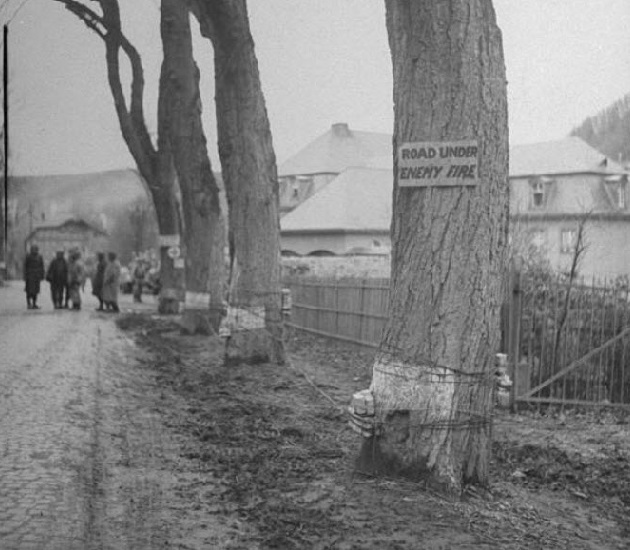
On the second day of the German offensive, December 17, the Allied lines was in flux as more and more US units were retreating from the oncoming panzers. Around 1200 hours, a convoy of trucks carrying Battery B, 285th Field Artillery Observation Battalion arrived in Malmédy coming from Heerlen, Holland. The battery commander ignored the engineers requests to stay and help defend Malmédy and their warnings of German forces to the southeast and insisted on following his original orders to link up with the US 7th Armored Division at St. Vith. At 1230 hours, the convoy left Malmédy and proceeded south on N-23 passed through the 291st roadblock and slowly grounded up a long steep hill then descended through Geromont to the crossroads at Baugnez which was named “Five Points” by the GIs.
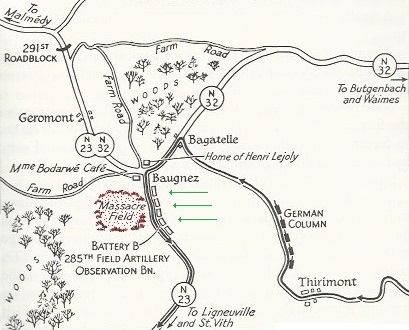
On the north end of the crossroads was the farm and home of Henri Lejoly who might have been loyal to the Germans. Diagonally across from Lejoly’s house and below the crossroads was the café/home of Madame Adele Bodarwé. Madame Bodarwé’s loyalties were not precisely known at the time. Two MPs of the 518th MP detachment in Malmédy were on duty at Five Points that day. The MP HQ in Malmédy had been alerted that elements of the US 7th Armored Division were routed down this road. Combat Command R (CCR) was the first segment and the second segment would be the division’s artillery. Slotted between the two segments was Battery B’s 285th Observation Battalion being sent with the artillery. Shortly after noon, the last vehicles of CCR passed south through the intersection. One of the MPs left to go to Malmédy for lunch. At 1245 hours, the lead vehicles of Battery B arrived at the intersection and were directed to the proper road by the remaining MP Pfc. Homer Ford. The convoy turned southward on N-23 and MP Ford kept the vehicles moving smoothly through the intersection. An ambulance belonging to the 26th Infantry Regiment, the last vehicle of the convoy, stopped and asked MP Ford for directions to Waimes. Instructions were given and the ambulance turned east on the road to Bagatelle.
Thinking that his duties were finished for the moment, MP Ford started to walk to the café when all of a sudden there was boom followed by more heavy gun explosions about 300 yards down the road. The Battery B convoy was being shelled by a German armored column from Kampfgruppe Peiper advancing north on a secondary road to the east. German grenadiers dismounted from the panzers and attacked west across the open field firing their machine pistols and rifles at the exposed Battery B column. The trucks taking hits slewed across the road, piled into each other and slid askew into the ditches on both sides of the road. GIs jumped out of the trucks taking what shelter they could find and some did not make it. Several GIs managed to run up the road towards the café. MP Ford waved them on to hurry and led them around behind the café. After hearing the commotion outside, Madame Bodarwé and Lejoly came out of the café and stood at the edge of the road witnessing the carnage. Panzers rumbled through the crossroads down N-23 made room for themselves by shoving the vehicles off the road and spraying them with machine gun fire until many burst into flames. GIs huddled in the ditches tried to escape but were mowed down before they could reach the woods. More German troops poured across the field and down the road joining the skirmish. The other German armored vehicles passed the café and closed the encirclement of the annihilated convoy.
Photos of the destroyed vehicles taken weeks later. Note the ambulance down the road.
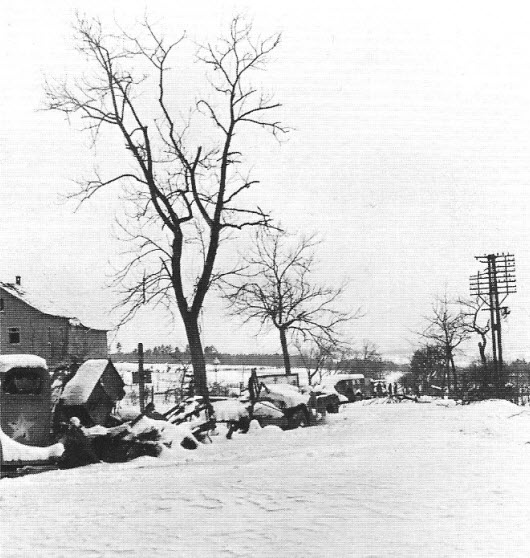
The markings on the destroyed GMC 2 1/2 ton truck bumper to the right was “1A – 285FOB B-2”. FOB stands for Forward Observation Battalion.
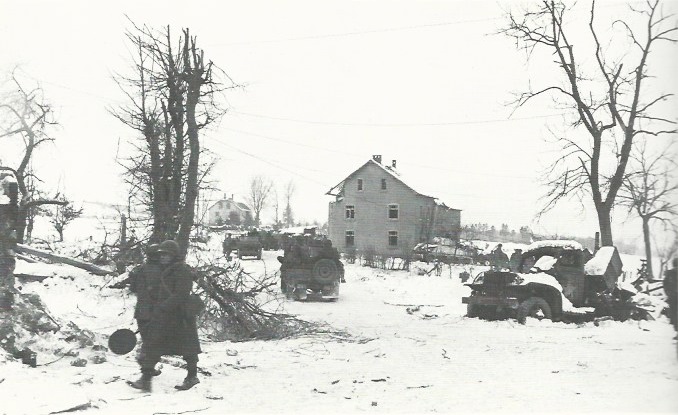
A German half-track rolled up and Major Josef Diefenthal wearing a light tan leather jacket got out. The gun fire began to died down and he began giving orders. There were a few more random shots and bursts from machine guns. The surviving GIs began climbing out of the ditches along the road, dropped their weapons and raised their hands up. These GIs were not front line soldiers and only had light weapons. One GI who was in the ditch had not surrendered however. T/5 Warren Schmidt found a little stream nearby with about a foot of water in it. He jumped into the icy cold water submerging himself with only his nose exposed. He dragged mud and weeds over himself so he looked very dead. The Germans collected all the guns and then searched the prisoners for anything of value such as maps, papers, wallets, rings, loose coins, wristwatches, gloves, lighters and cigarettes. The prisoners were shoved and pushed along the shoulder of the road. A command car then drove up with another officer in it and shortly the German armored column began to move again heading south down N-23. The Germans said the officer was Major or SS Sturmbannführer Werner Poetschke, the commander of the 1st SS Panzer Regiment. The line of prisoners began to move up the road towards the café. Fearing detection, MP Ford and the GIs hiding behind the café then sprinted across an open stretch of ground to a close by barn and hid inside. The Germans moved the prisoners into the open field just below the café and the crossroads. Then 8 or 10 Germans swept around the café converging on the barn and surrounded the building. It was believed Lejoly might have informed the Germans of their location. The Germans shouted at the GIs to come out threatening to burn the building if they did not. MP Ford and the GIs came out, dropped their weapons and surrendered. Then they were added to the group in the field. More prisoners captured in the area were herded and added to the group including the two Medical corpsmen who had been in the 26th Infantry Regiment ambulance, Samuel Dobyns and Roy Anderson. They ran smack into the German armored column between Five Points and the next crossroads at Bagatelle only a third of a mile away. They were ran into the ditch, captured and then their ambulance was burned.
The captured GIs were informed of who their captors were. One of the tankers laughed at them and said in good English. “First SS Panzer Division welcomes you to Belgium, gentlemen.” The GIs were a little uneasy because they were SS troops wearing the Death’s Head insignia on their caps. The prisoners surrounded by the Germans stood in the field waited for what seemed a long time.
A German officer stopped a passing SP half track mounting a 88 (more likely it was a Sd.Kfz. 251/22 with a 75mm PaK 40 AT gun.) The half track maneuvered around trying to bring their big gun to bear on the prisoners. The gun would not depress far enough. The officer waved it on but the half track got stuck in the soft mud along the shoulder of the road which caused a minor traffic jam as the following vehicles had to veer around it. Horns beeped and drivers yelled at the mired half track. Angrily, the officer stopped the next two passing panzers. He wanted some heavy weapons to help guard the American prisoners, he explained. The first panzer stopped was Pz.Kpfw. IV number 731 commanded by Oberfeldwebel (Sergeant Major) Hans Siptrott. The driver was Unteroffizier (Corporal) Gerhard Schaeffer. The rest of the crew was Unteroffizier Wetengel, gunner, Soldat (Private) George Fleps, assistant gunner and Soldat Arnhold, radioman. Fleps stood in the panzer turret with his pistol in hand pointing at the prisoners. The second panzer stopped was Pz.Kpfw. IV number 732 commanded by Unterfeldwebel (Sergeant) Clotten and the driver was Unteroffizier Koewitz. Another member of this crew was Soldat Vogt. The two panzers were maneuvered into positions to allow them to cover the field from both ends and the panzers brought their machine guns to bear on the prisoners.
There was then another lull while the prisoners stood in the field and waited. They were cold and still believed that the long wait was for trucks to come up to take them to a POW camp but the wait was actually for rear elements of the column to come up. The first rear element to arrive was a company of combat engineers, the 3rd SS Pioneer Kompanie. Major Poetschke conferred with their commander and then left. Soon after the Major left, one of the Pioneer officers approached Panzer 731 and gave the order “The prisoners are to be killed.” to Siptrott, Panzer 731 commander. He also stated that it done quickly because everybody was needed up ahead and that there was no time to waste.
Siptrott stated that he didn’t have enough ammunition but the officer told him to do as he was ordered. Siptrott turned to Fleps who had hispistol ready and ordered him to start shooting the prisoners. Fleps shot one of the prisoners in the front row who toppled over backwards. The GIs started yelling and at least two men in the front row bolted and began bulldogging their way through the group to the rear. A prisoner officer, Lieutenant Lary feared the men will break and run resulting in further fire, shouted “Stand Fast! Stand Fast!” Fleps then fired at another prisoner. Immediately after this shot was fired, within seconds, the machine guns of both panzers opened fire. The prisoners screamed and yelled, many of them instinctively dropping to the ground while others just stood about. The machine guns raked back and forth across the group mowing the men down. The whole event had taken about five minutes and when it ended the time was around 1410 hours. The two panzers then moved on down the road. Up the road, Henri Lejoly witnessed the entire scene. But not all the prisoners were dead. A number of them were just wounded and/or playing dead. Several soldiers of the pioneer unit went into the field and walked around among the bodies poking and kicking them. If any of the bodies showed any sign of life, the pioneer finished him off.
Eventually it all ended but the ordeal for the surviving GIs was not over. There was no more shooting and the long column passing on the road had all gone by. It was estimated around 50 panzers and about the same number of half tracks had passed by. The men in the field still living laid still and silent for about 20 to 30 minutes after the long column had stopped rolling by, but they were whispering among themselves. The exact number of men still alive and spoke up was not precisely known. Then they began to talk about making a dash to the woods and some 15 or 20 thought they were not too badly wounded to try but they wanted to do it right away. Lieutenant Lary urged the group to wait until dark to try because a group of Germans were guarding the crossroads and they would have a better chance. They occasionally heard the Germans talking. The men feared more Germans might come along and finish them off.
Finally, Private James P. Massara, one of the men who was not wounded, stood up and yelled “Let’s go!” and led the men in a sprint. In a more or less a solid pack, the men ran northward up the field toward Malmédy. The Germans guarding the crossroads spotted the fleeing men and turned their machine gun on them. Lieutenant Lary, who decided to make the dash with the men, saw one of the men drop. The others kept going. Around 15 men including Massara and MP Ford reached safety in the woods and hid. But about twelve men including Lieutenant Lary and T/5 Theodore Paluch swerved towards Madame Bodarwé’s café when the machine gun opened fire on them. Lary yelled at the men not to go inside the café but to follow him. Paluch and three men followed Lary behind the café. Six or seven men decided to duck into the café. When Lary ran around behind the café, he saw a small shed and dived into it. There was a pile of straw and other debris in one corner and he hid in it and covered himself with the straw. Paluch and other men did not see where Lary had gone, stayed behind the café and played dead. After seeing the men run into the café, the Germans guarding the crossroads turned their attention from the fleeing men to the café. They dismounted their machine gun and approached the café. When they were not able to flush the GIs out with threats, they set the café on fire. Before long the men were smoked out and as they exited the café, the Germans turned their machine gun on them and mowed them down. As the building began to burn, the men hiding behind it crawled off, partially covered by the smoke, and reached safety in the woods.
The men of the 291st heard the gun fire from the southeast. Lieutenant Colonel Pergrin and Sergeant Bill Crickenberger drove the command jeep down the road towards Five Points to investigate. About a half mile away, they left the jeep and advanced on foot. In a pasture, they encountered three of the survivors who reported the details of the massacre and at the end of the day there were only a total of 29 survivors. Pergrin reported the atrocity to the US 1st Army HQ and news of the massacre spread to other units in the area.
Madame Bodarwé simply disappeared and was never seen again after that afternoon. It was not until 14 January 1945 when the 291st engineers were able to search and locate the GI bodies at the massacre site using mine detector gear. Major Werner Poetschke was KIA on the Austrian front in the spring of 1945.
This is an US Army aerial photograph of Baugnez taken in April 1947. After the war, the ruins of Madame Bodarwé’s café were torn down.

The scene in the 1965 movie “Battle of the Bulge” of this event is not accurate. It portrayed the event as the US prisoners were gathered in a secluded clearing in the forrest and the SS troops knowingly massacred them with only one US officer who escaped.
Movie Clip: Americans Massacred By SS Troops
The US 30th infantry Division was not able to get to Malmédy in time. The only forces the US 1st Army HQ were able to rush to Malmédy was only some of its security units. The 99th Infantry Battalion (Separate), based at Tilff northwest of Spa and the 526th Armored Infantry Battalion (AIB) and one company from the 825th Tank Destroyer Battalion (towed 3 inch guns) based at Spa were ordered to move towards Malmédy immediately.
The 99th Infantry Battalion was an unique elite unit which consisted of Norwegians and Americans with direct Norwegian descent. All the soldiers in this unit had a working knowledge of the Norwegian language and were trained to ski and fight in winter conditions. Most of the men were Norwegian ex-seamen that were stranded around the world and who still wanted to fight for Norway against the Axis. There were also a large number of US Army soldiers that were either first or second generation Norwegian immigrants and were hand picked for this unit. Lieutenant Colonel H. D. Hansen, the commander of the 99th Infantry Battalion was given command of all three units which became Task Force Hansen and it was attached to the US 30th Infantry Division.
US troops advancing south towards Malmédy. The WC-63 towing an AT gun on the left appears to have the code “1HQ-11” on the front left bumper. The US M3A1 half track on the right also is towing an AT gun and barely visible on the front bumper is the number “526” where a censor has scratched out the unit codes.

On December 17, the 99th Infantry Battalion, 526th AIB and the 825th Tank Destroyer Battalion arrived in Malmédy. Elements of the three units were spread out to reinforce the defenses at Malmédy, Stavelot and Trois-Ponts. Kampfgruppe Peiper’s next objective was Stavelot on the road to Malmédy. Outside Stavelot, the 291st engineers managed to knocked out the lead panzer with a bazooka and stalled the German column for the night. Overnight, the 99th Battalion, 526th AIB and 825th Tank Destroyers arrived and setup defensive positions around the vital Stavelot bridge. Soon after sun raise, two tank destroyers and the two towing half tracks were blown apart. By 0830 hours on the 18th, the German panzers sped across the still intact bridge and captured Stavelot. Then the German panzers wheeled southwest towards Trois-Ponts. At Trois-Ponts, the US infantry and Tank Destroyers repelled the panzers and the engineers blown all the bridges in the area. The German advance had stalled due to the hardening US defensive and the only route left to the Meuse River was through Malmédy.
During the afternoon of December 20, one of Skorzeny’s men (a Dutch deserter) was captured in the outskirts of Malmédy and during interrogation that evening he said, among other things, that a strong attack against Malmédy would be launched around 0330 hours the next morning. Immediately G-2 (intelligence) informed all commanders and most of men along the defensive lines of the expected attack.
The German unit ordered to attack Malmédy was SS Panzerbrigade 150 commanded by Obersturmbannführer Otto Skorzeny. Ill-equipped and under gunned for such an assault, Skorzeny’s elite troops were being used as cannon fodder in this attack on Malmédy. On December 20, Panzerbrigade 150 Kampfgruppe X and Kampfgruppe Y gathered near Ligneuville. Kampfgruppe Z at the time was too far away and was held in reserve. Most of the men wore German uniforms but some wore olive drab trousers and US combat boots with German tunics. A few were dressed head to toe as American GIs. The vehicles were captured US M8 armored cars, trucks and jeeps, supported by StuG IIIs and Panthers disguised to appear like US M10 tank destroyers.
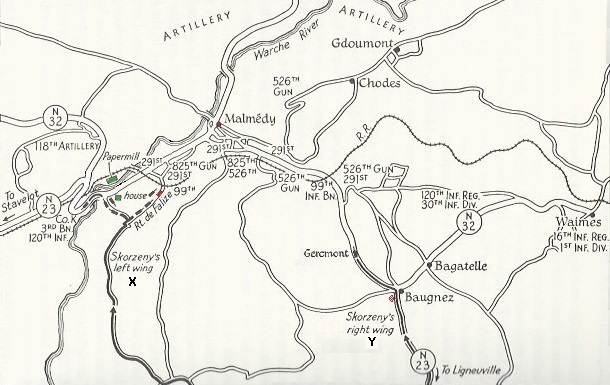
On the left wing, Kampfgruppe X was the stronger attack group consisted of two kompanies of infantrie supported by the disguised Panthers. The Panthers carried fake codes for B company, 10th Tank Battalion, US 5th Armoured Division. At that time, the actual US 5th Armored Division was fighting in Schneidhausen and Untermaubach, Germany. After the battle, four of the knocked out Panthers clearly displayed the fake unit codes for vehicles B-4, B-5, B-7 and B-10.
Advancing north from Ligneuville through Bellevaus and along the Route de Falize, Kampfgruppe X strucked the US positions west of Malmédy at 0430 hours. At the bottom of the hill, part of the column continued up the road heading east towards Malmédy while the main body turned left onto a road heading north to the Warche River bridge.
The smaller group heading towards Malmédy advanced with guns ablazing. The lead Panther B-4 ran over a mine in front of the railway overpass and brewed up blocking the following Panthers. Company B of the Norwegian 99th Infantry Battalion manning positions on top of the railway embankment opened fire on the Panthers which were trying to maneuver around the disabled lead Panther and on the grenadiers who were charging the whole railway embankment. Several times the Germans reached the foot of the embankment and could go no further. Again and again, German MG crews tried to setup their weapons in front of the embankment but were wiped out by the intense fire. The US 118th Artillery regiment (105mm guns) positioned on the hills north of the Warche River shelled the area using new proximity fused shells (See more information on Proximity Fuses below). The Germans were roughly dealt with. A large number were killed by the shell bursts and for a moment panic spread among them, some running forward into the fire shouting “Kamerad” (means “Buddy”). After two hours of fierce fighting, the assault died down and the grenadiers slowly fell back with their dead littering the area and the knocked out Panther blazing like a torch sending up sparks which flickered across the predawn sky.
This is the leading Panther coded B-4 commanded by Leutant Peter Mandt which was knocked out by the mine in front of the railway overpass on Route de Falize.

Film: German Ersatz M10 TDs in Battle of the Bulge
This is the railway overpass today. The road on the left did not exist in 1944.

Meanwhile, the Panthers of the main body advanced along the road to the Warche River bridge and approached the house on the corner. Grenadiers were advancing in the fields along the road and somewhere in a field while getting into position to attack the house, a US trip wire was triggered, setting off flares, and suddenly the whole area was lit up. The two story house on the corner was used as the command post of a platoon of 825th Tank Destroyer 3 inch AT guns and it became surrounded by the attacking grenadiers. Trapped inside were the GIs from the TD unit, 291st engineers and a handful of GIs from the 120th Infantry Regiment. About 33 men total, positioned at every window putting out rifle and bazooka fire. The German attack made some headway, as one Panther advanced while the other Panthers provided supporting fire. The grenadiers got close enough to the house to toss hand grenades in a window before being forced to retire. An advancing Panther passed the house, maneuvered around, and gone down the road to cross the bridge to the far side of the river. Another Panther took a position to cover the bridge and from there it opened fire against the house. One of its first shells hit the kitchen, killing three GIs inside. As the Panthers moved pass the house on the corner, the 825th 3 inch AT guns opened up on them from up the road from the direction of Malmédy. The battle intensified with the whole area was swarming with grenadiers. The house was sprayed with MG fire killing more GIs inside. The fight around the paper mill and the Warche bridge continued. The line held by the American infantry had been driven back some distance. Some grenadiers and Panthers crossed to the north bank of the river but the Americans were still stemming the attack.
Around 1030 hours, the fog that had settled over the area in the early morning suddenly lifted, revealing the action near the paper mill for the men on the railway embankment to the east. Trapped inside the house, a handful of defenders continued to hold out. Because it was thought that the house was occupied by Germans and was being used as a command post, it came under fire from the railway embankment. US artillery positioned in the hills north of Malmédy determined the range and started to plastered the area. All morning the battle raged around the house, in which by early afternoon only 12 GIs remained. Two brave men decided to try to get help and made a dash through the intense fire to the paper mill yard and made their way towards Malmédy. They ran into an American MG position and were taken to the American command post where they reported that the house was in American hands and had been all day. The US artillery had fired an overwhelming 3,000 shells by the time the fighting around the paper mill and the bridge slowly subsided during the afternoon. The grenadiers held on grimly around the paper mill and the bridge. The remaining Panthers fought on and covered the grenadiers as they slowly disengaged. By mid-afternoon, Skorzeny gave orders for what was left of the brigade to withdraw. Panzerbrigade 150 was finally withdrawn from the front lines on December 28 and was replaced by 18th Volksgrenadier Division.
Panther B-7 reached the north bank of the Warche River and was stopped by artillery fire 50 meters from the bridge. The crew bailed out and tried to run to safety across the bridge in the background but were cut down by US gun fire. Only the radio operator Karl Meinhardt survived.
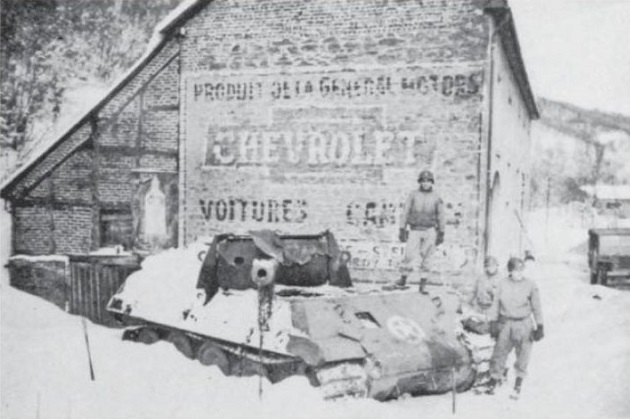
This is the front end of Panther B-7 showing the fake unit codes.
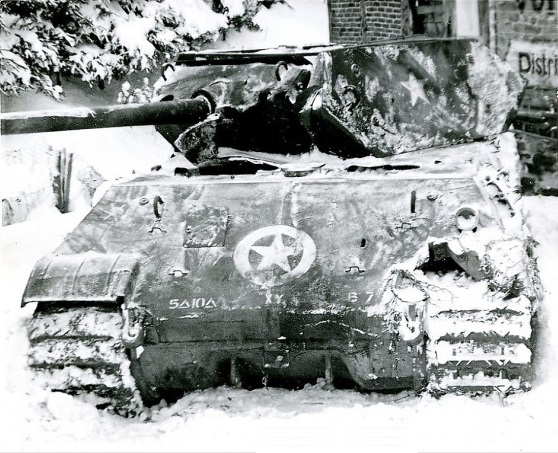
This is the rear end of Panther B-7. The rear plates of the turret disguise are removed. They probably were ejected when the crew bailed out.
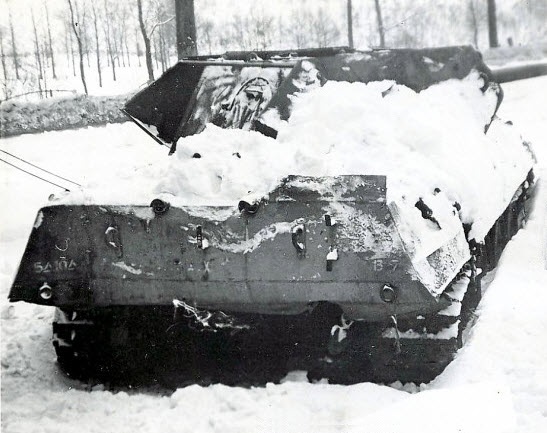
A side view of Panther B-7 surrounded by deep snow.
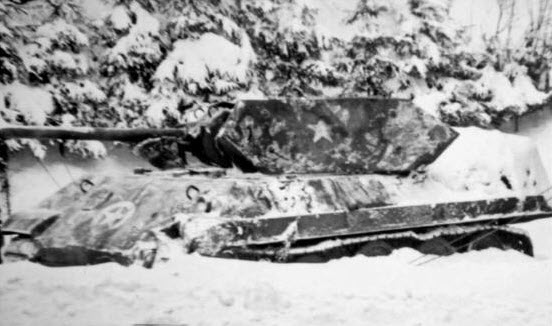
GIs poising on Panther B-7. The photos probably was taken in the early spring of 1945.
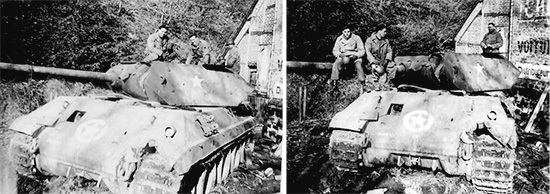
Another view of Panther B-7 next to the building probably sometime in 1945. The muzzle break was removed and the square cover plate on the front hull where the MG port was located has also been removed.

This is probably a post war photo indicated by the civilian sitting on the Panther. The location was probably used as a collection point.
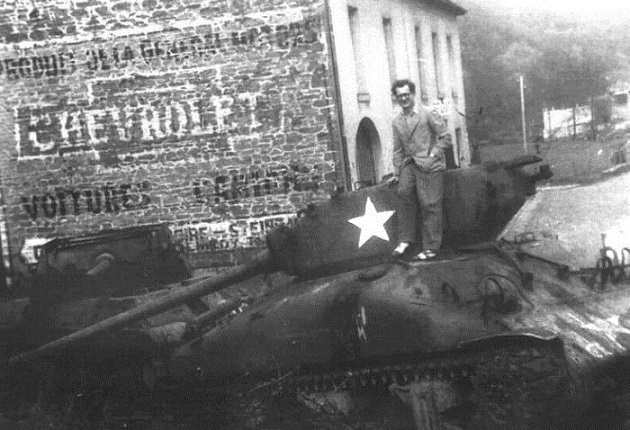
In this post war photo, the Panther has been exposed to the weather. Note the grass has grown around the Panther.
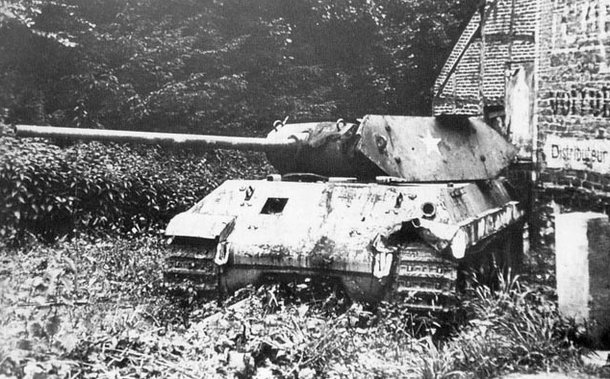
Panther B-10 was commanded by Leutant Gerstenschlager. Because the Panther had no cupola, Gerstenschlager was hit in the head when he peered out to orientate himself. Then the Panther came under heavy US artillery fire. The driver tried to escape but drove the Panther into the Café Du Rocher de Falize at La Falize. The crew pannicked and abandoned the Panther.
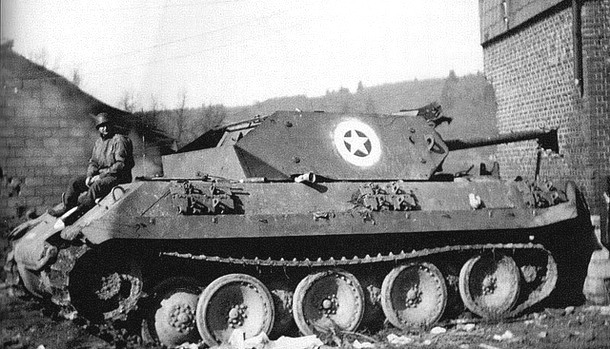
GIs posing on Panther B-10. The fake unit codes can be seen on the front hull.
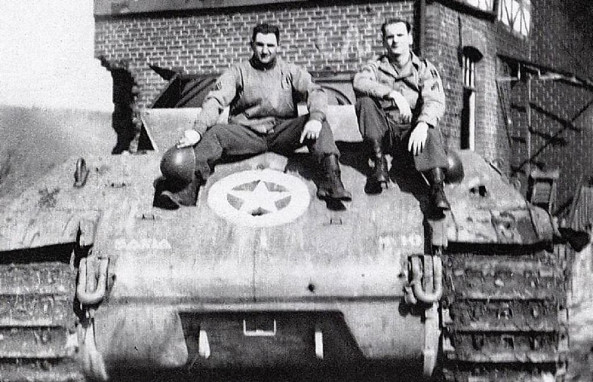
Another photo of Panther B-10 later covered with snow.

This photo shows the right side of Panther B-10 and the gaping hole in the corner of the café.

Civilians posing next to and on Panther B-10.
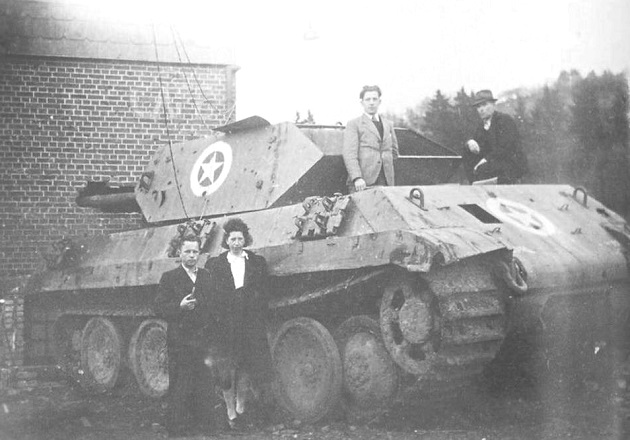
In this post war photo, the café side wall has been rebuilt. The Panther turret has been transversed. The table and chairs shows the café might be back in business. Note the muzzle break on the ground near the Panther’s Idler wheel.
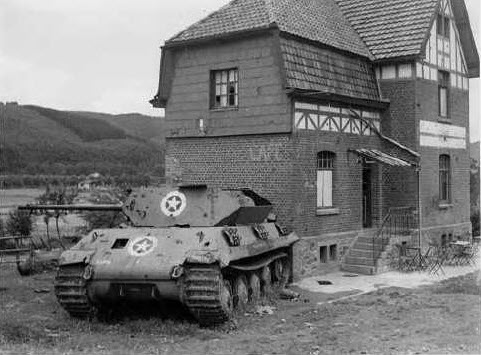
This is the building today. It has an addition on the left added on and appears to be a private residence now. Continuing to the right leads to the railway overpass where Panther B-4 was knocked out. The road around the corner heads north to the paper mill (today AHLSTROM) and the Warche River bridge.
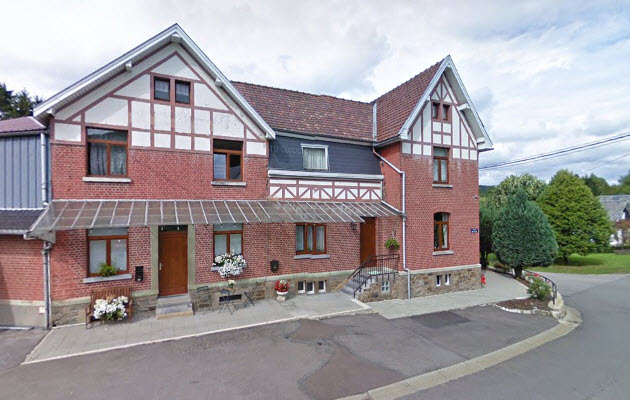
The top of the wall on the east side of the buidling still has “CAFE” painted on it but it is not listed as a business.
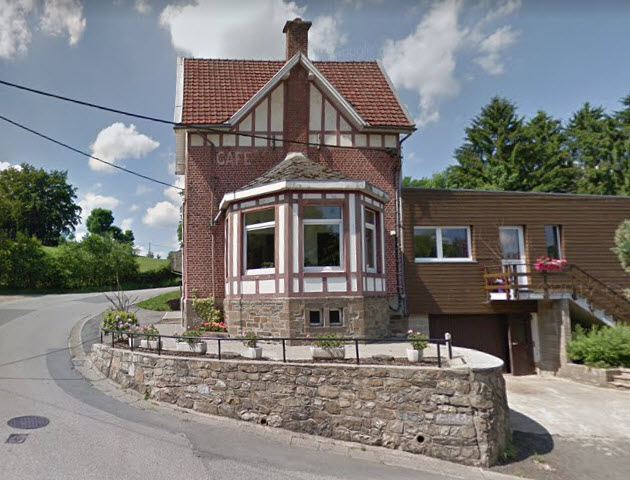
Panther B-5 was disabled by a bazooka and abandoned.

This Panther (unknown code) was knocked out. Part of the turret disguise with a circled star is leaning against the front side of the hull.

This is a map overlay from the National Archives updated to show the locations of Panthers B-4, B-7 and B-10.
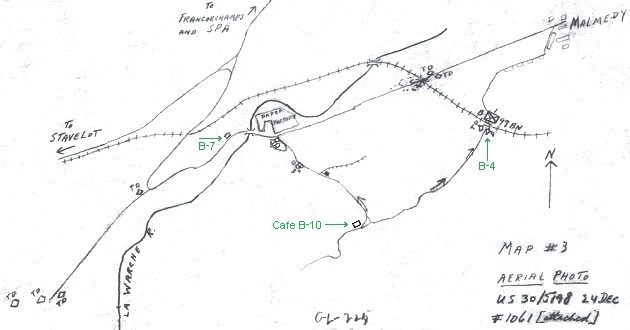
On the right wing, Kampfgruppe Y was the weaker attack group consisting of infantrie supported by disguised Sturmgeschutz III Ausf Gs. Kampfgruppe Y advanced north from Ligneuville along N-23 towards Malmédy passing the massacre site from 4 days earlier. The motorized column ran into the 1st Battalion, 120th Infantry Regiment defenses along the main road to Waines. A German half-track ran over several mines across the road exploded and sent equipment (most captured American) flying along the sides of the road. The kampfgruppe then came under a tremendous US artillery barrage taking heavy losses and was forced to withdraw back to Ligneuville.
Another encounter occurred along N-23 at 0230 hours on December 22. Two GIs were guarding a road block along the Malmédy road 300 yards north of Géromont. Visibility was poor, but through the mist the two GIs spotted the bright headlights of an American half track advancing from the south towards a minefield 100 yards in front of the front lines. Behind the half track, the GIs could hear a noisy column of panzers, armored cars and more half tracks. Suddenly the column halted; the enemy could be seen around the vehicles and some were removing the mines from the road. The GIs fired several bursts from their BARs over the column as warning shots. From the column came voices protesting in English that they were friendly troops and asked if they were not American, why would they have their head lights on? Not believing them, the GIs fired a few more bursts. Voices from the column beckoned the GIs to come down to them and they said they had some pretty freuliens with them. The GIs were not tempted and then they began to receive return fire from the column. The GIs immediately alerted their lines and mortar flares were sent up. A bazooka man crept up and fired at the leading half track which was disabled and at the other vehicles in the column. By that time, the US mortars and artillery had zeroed in on the column and opened fire. The enemy column retreated.
Fearing the Germans would launch a counter attack against Malmédy, at 1400 hours 291st engineers brought down the immense stone-arched railway bridge on N-32 with 2,300 lbs of TNT completely blocking the road almost to the top of the embankment. The bridge carrying the railway line over the Route de Falize was also demolished as well as the Warche river bridge near the paper mill.
Although most of the fighting occurred around the town of Malmédy, but the town itself was not spared. The USAAC erroneously bombed the town of Malmédy twice. Around 1526 hours on December 23, six B-26s of the 322nd Bombardment Group (BG), US 9th Air Force, dropped 86 250 lbs General Purpose (GP) bombs on the town. Then around 1600 hours on December 25, four B-26s of the 387th BG, US 8th Air Force, dropped 64 250 lbs GP bombs on the town.
On 15 January 1945, this Panzerbrigade 150 Sturmgeschutz III Ausf. G part of the Kampfgruppe Y was abandoned along N32 at Géromont. 291st Combat Engineers are removing a booby traps from it. Note the communication wire draped over the Sturmgeschutz and the Notek light for night driving (named after the company, Nova-Technik GmbH, that made them in Munich) beside the gun travel lock. This Sturmgeschutz could been part of the column that advanced on December 22.

A US Major indicated by golden oak leafs on his helmet is posing on this Panzerbrigade 150 Sturmgeschutz III. The snow was cleared off the fake unit codes on the front hull. The vehicle number on the left side is not clear.

Another Panzerbrigade 150 Sturmgeschutz III coded as C-5, 81st Tank Battalion, 5th Armor Division, was abandoned somewhere between Baugnez (Five Points) and Géromont. Note the muzzle break has been removed.

Side view of Sturmgeschutz III C-5.

The rear engine deck of Sturmgeschutz III C-5. Note the fake unit codes on the rear plate.

Note the open engine and service hatches on Sturmgeschutz III C-5.
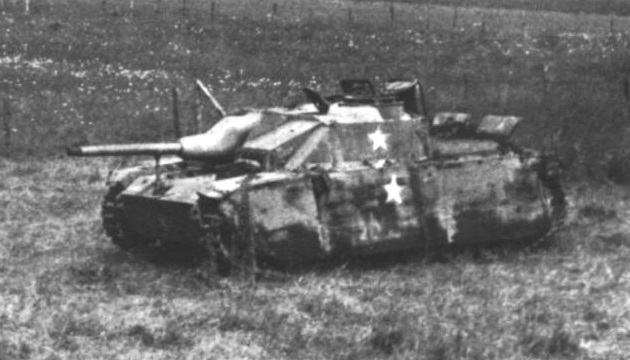
ERSATZ PANTHER DETAILS
ERSATZ means “Replacement” in German. These Panthers were carefully and cleverly disguised to appear as a US M10 Tank Destroyer with utmost attention given to the details. This attempted deception took a large amount of work in order to imitate the appearance of the M10. The time, work, and materials involved as well as the technical research of the M10 required, definitely indicate fourth or fifth echelon modifications but it was believed that the work was done by German maintenance units rather than at a factory.
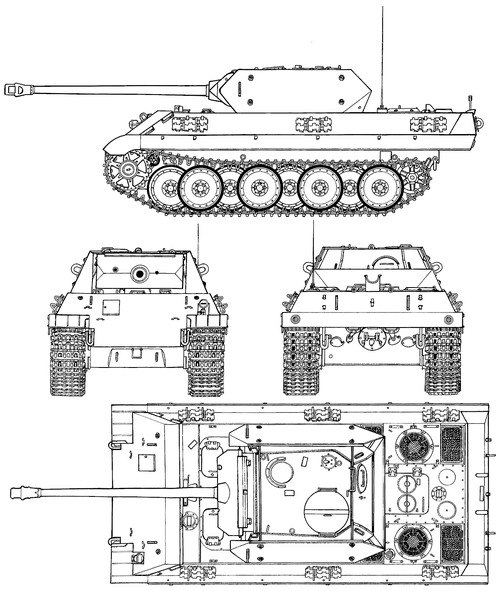
The Panther was camouflaged or disguised using sheet metal. The sheet metal used on the turret and on the upper bow was 3/22″ (3.46mm) thick and that on the slides of the hull was 9/64″ (3.57mm) thick. The lower part of the false bow was thicker, probably made of a double plates. The construction probably have been divided in into four parts: Turret, Bow, Rear and Sides.
The turret was disguised using five pieces of sheet metal. Two pieces were cut to shape to resemble the distinctive sides of the M10 turret. Those pieces were than flanged on the edges, bent to shape, and stiffened with small angle iron. The gun shield was carefully formed from another sheet to the exact shape of the M10 gun shield. A hole was made to the right of the gun hole in the shield for the Panther’s co-axial MG 34. Note that there was no similar hole in the shield of the M10. Finally the rear of the turret was made of two pieces of sheet metal. One piece to represent the bottom slant surface of the rear, and the another piece to represent the counterweight of the M10 turret. The pieces representing the sides and rear were joined together and braced with angle iron and the whole was attached to the Panther turret.
The following photos are of the turret of Panther B-7.

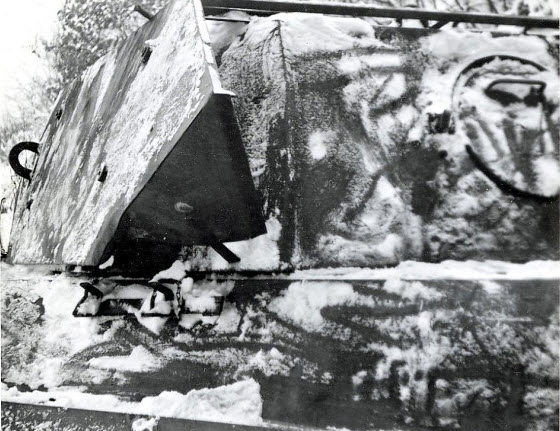
All of the lifting rings, brackets, extra-armor studs, etc., found on the turret of the M10 were carefully duplicated and welded to the false turret assembly.
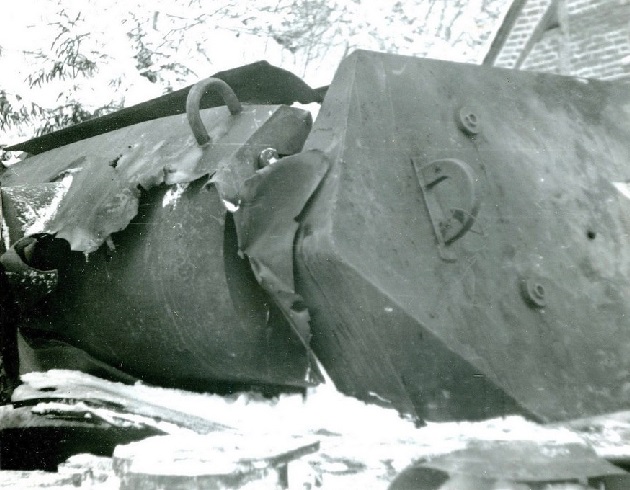
The distinctive Panther commander’s cupola was removed from the turret. In its place, two semi-circular hatch covers were hinged to the turret top to cover the opening.
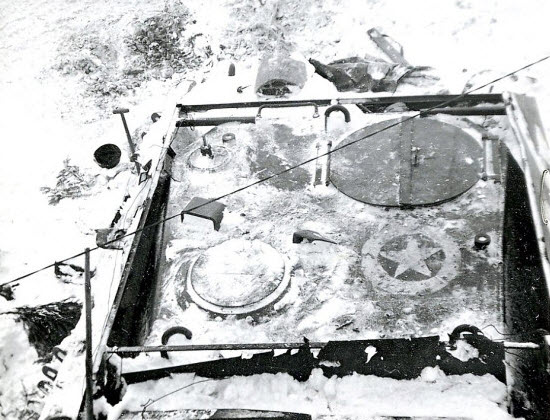
Extra water cans, fuel cans, the rammer staff container and other accessories stowed on the outside of the Panther were removed. The dome hull machine gun port was removed and replaced with a square cover hatch. Inside the one panther which was not blown apart were found items of GI clothing such as helmets, overcoats and leggings.
The characteristics which were not disguised and could not easily be camouflaged were:
– The distinctive Panther overlapping road wheel suspension.
(The M18 Tank Destroyer had a somewhat similar suspension.)
– The muzzle brake on the Panther’s 75mm KwK 42 gun
(The new M4A3E8 did have a muzzle brake.)
– The wide and distinctive tracks on the Panther.
(The new M4A3E8 did have the T66 single pin 23″ wide tracks.)
PROXIMITY FUSE
A masterpiece of electronic engineering and one of the most useful developments of WWII. This fuse contained a miniature radar transmitter and receiver powerful enough to detonate the shell when a target was detected.
In the autumn of 1940, a scientific mission led by Sir Henry Tizard came to the USA in order to exchange information with American Scientists and enlist their help in solving some of the scientific problems facing Britain at the time. Among many of the projects revealed by the mission were the first British research materials on the atomic bomb, the cavity magnetron which led to the development of the microwave radar and the plans for the proximity fuse.
The US Navy took on the development of the fuse, and they enlisted the aid of a variety of US commerical companies: Eastman Kodak for the general design, Exide for the special batteries, and Sylvania for the tiny valves. Vast resources were poured into the programme and in 1942 working fuses were fired, proved effective and production began. By the end of the 1942, 5,000 of the new fuses were shipped to the southwest Pacific where they were distributed to the US carriers Enterprise and Saratoga, and the light cruiser USS Helena. The proximity fuse was first used in combat on 5 January 1943. A cruiser and destroyer task force was returning to Guadalcanal in the Solomon Islands after a raid against enemy airfields when Japanese dive-bombers struck. On board the Helena, the 5-inch AA guns opened up on one of the bombers and brought it down with a salvo. It was the first of many. By the end of the year, about half of the hits on Japanese planes had been credited to the new fuse.
The proximity fuse (or “Pozit” fuse, or “Peter” fuse or “VT” fuse – it had a variety of names in the early days for security reasons) was a self contained radio transmitter and receiver built into an oversized fuse. The head section carried the radio components and aerial, the body of the shell also formed part of the aerial array. The shank of the fuse, concealed inside the shell body when the two were assembled together, contained a powerful battery and a number of safety devices which ensure that the fuse would not activate in or near the gun. The battery was a number of doughnut shaped plates surrounding a glass ampoule of electrolyte. Until the fuse was fired from a gun, the battery was quite inert, but once fired from a gun the ampoule broke and allowed the acid to run into the cavity of the plates. The spinning of the shell in flight caused the acid to spread over the plates by centrifugal force, and within three seconds the battery delivered 140 volts, which was tapped off in suitable amounts to power the receiver, transmitter, and charge up the firing condenser. Once the battery was alive, the transmitter began radiating signals from the aerial, and the polar diagram of the signal was matched to the lethal burst area of the shell’s fragments. That made sure that any item which reflected the signal was in the best place to receive the maximum damage. When the shell approached the target, the signal from the aerial was reflected back and picked up by the receiver, and when the strength of this signal indicated that the shell was within lethal distance of the target, the receiver triggered a firiing circuit which allowed the firing condenser to discharge into an electric detonator thus detonating the shell.
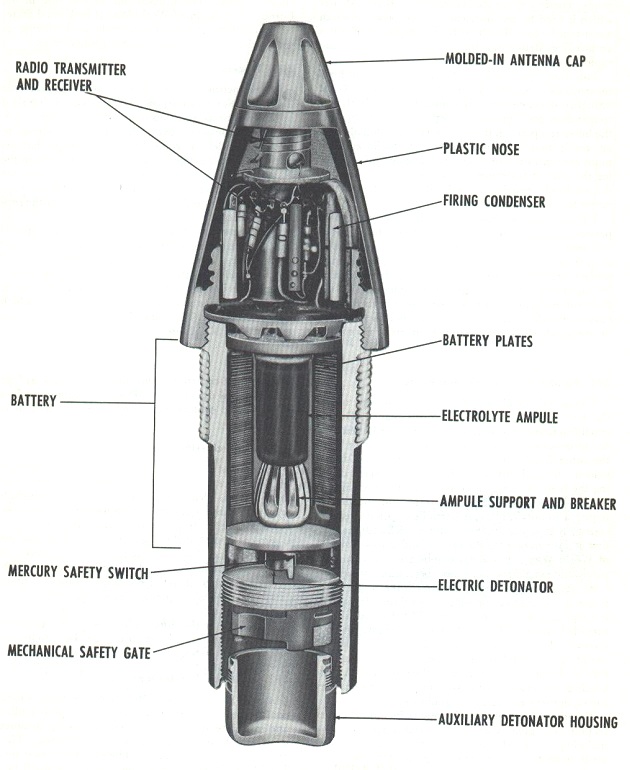
In early 1944, models suitable for use in British guns were in production and were shipped to Britain. They were just in time as on 13 June 1944, the Germans launched their V-1 flying bomb campaign against England. There was a constant danger that a fuse might not function properly and might fall back to earth without detonating the shell and fall into German hands. So all guns using the Proximity fuses were positioned along the south coast of England leaving the Channel and island zones for the RAF fighters. The guns were setup to fire over water so that any duds would fall into the water. The following seven weeks the guns destroyed 1198 V-1s out of a total of 3800 launched, the proportion downed by guns increased from 43% to 83%.
US Army Artillery
The release of the artillery shells with the new proximity fuse took a little longer where the Ardennes offensive provided the final incentive. Early on the morning of December 16, one of the German’s first targets was the 38th Cavalry Squadron, dug in around Monschau, Germany. The lightly armed cavalry troopers needed help, and the commander urgently called for artillery support from the US 406th Artillery Group. The 406th had a batch of new secret artillery shells. At that time, Allied commander Dwight Eisenhower had not yet given permission to use the new fuse in the ETO. The commander of the 406th, Colonel George Axelson made the decision that the emergency trumped the restrictions and ordered his gunners to use the new shells. Minutes later, rounds equipped with the new fuse started exploding right over the heads of the attacking Germans and the attack collapsed. Three days later on December 19, Eisenhower formally asked for clearance. Two days after that, all restrictions were removed just in time to help repell the German attack on Malmédy.
Artillery shells with the standard fuses would impact the ground and then explode spraying shrapnel upwards in a cone shape pattern. Shells with the proximity fuse would detonate about 30 feet (9.144 meters) above the ground and shower the target area with shrapnel. Before the proximity fuse, this effect was only achieved when artillery shells were fired into a wooded area where the shells would hit the tree tops and explode.
Cutaway view of the radio proximal fuse designed by the National Bureau of Standards for the US Army. The fuse screwed into the nose of the artillery shell and exploded when radio contact was made with the target.

MODEL AND CONVERSION KITS
1/35:
CMK 3039 Panther G Ersatz M-10 – conversion set Tamiya – 2003
Dragon 6561 Ersatz M10 – 2009
1/48:
Gaso.line GAS50809K Ersatz Panther / TD M10 Conversion
Hauler HLX48207 Panther G ERSATZ M-10
1/72:
Aleran Minis MS-4 Ersatz M10 (Panther) Decals
Dragon 7491 Ersatz M10 – 2012

Spot on with this write-up, I absolutely believe that this amazing site needs a lot more attention. I’ll probably be returning to see more, thanks for the information!
LikeLike
Brilliant post, very informative thank you.
Do you have any details on what the house and what the Paper Mill looked like at the time of the fighting around the Warche Bridge, is there an aerial photo of the battle site?
LikeLike
Interesting websites have never enough traffic until you don’t put a million USD in advertising … I have the exact same problem … eucmh.com
LikeLike
Very well done. TF Hansen was the execution of First USArmy’s security plans. 12th Army Group released the 526th AIB(-) to FUSA on request. The battalion was part of T-Force, with one company detailed to Army Group HQ as a Security Force, just as the 99th had 50 men at FUSA HQ.
LikeLike
Ferez-vous aussi un article en vous basant sur les recherches du Canadien James Baque sur les innombrables massacres de prisonniers allemands lors du D-Day et après jusqu’en Allemagne ou des dizaines de milliers perdirent leur vie? Ou sur les 1 millions de morts de POW allemands dans les plaines du Rhin ordonné par D. Eisenhower? Merci d’avance, j’ai des photos.
Will you also do an article based on the research of Canadian James Baque on the countless massacres of German prisoners during D-Day and after in Germany where tens of thousands lost their lives? Or about the 1 million German POW deaths on the Rhine plains ordered by D. Eisenhower? Thanks in advance, I have pictures.
LikeLike